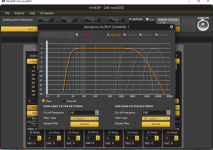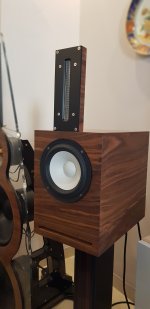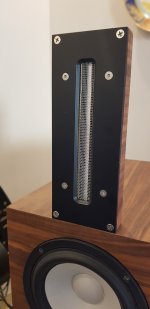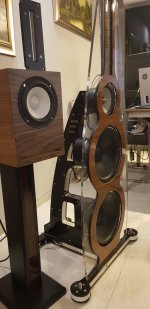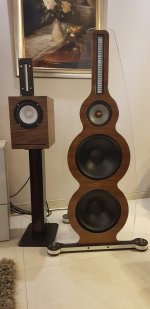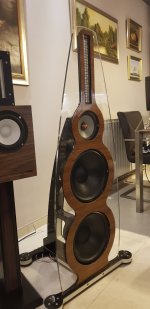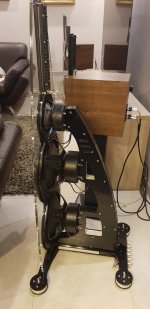- I had forgotten about the pass units. also someone else reminded me that Marchland makes some good units.
- Your right inspector , I should have said that Joseph Crowe said in the video that his tests show the noise floor was lower and he likes the sound of Xkitz better than the miniDSP ...
I have heard that same comment about the noise floor a few times though... also heard people say there are better units out there
- There are a few guys who's speaker projects interested me, and I have been following along and they were using active setups , several of them had tried both units and moved on for one reason or another. I guess everyone has there favorite
- Your right inspector , I should have said that Joseph Crowe said in the video that his tests show the noise floor was lower and he likes the sound of Xkitz better than the miniDSP ...
I have heard that same comment about the noise floor a few times though... also heard people say there are better units out there
- There are a few guys who's speaker projects interested me, and I have been following along and they were using active setups , several of them had tried both units and moved on for one reason or another. I guess everyone has there favorite
Last edited:
Marchand units were ok in the 80s. We've moved on a bit(IMO)- I had forgotten about the pass units. also someone else reminded me that Marchland makes some good units.
but no measurements! I would love to see an apples to apples on this.I have heard that same comment about the noise floor a few times though... also heard people say there are better units out there
- Your right about the measurements of course , but missing that all that's left is subjective opinion ...
- here comes another opinion... 🙂 I've heard good things about Xilica 4080 , from several people...
-----------------------------------------------------------------
------------ ( I apologize if this next part is a little confusing, my meds are making me a little loopy tonight... )
- BUT there are some New ideas over at the Klipsch forum.... at least to me.... and a few others.
- there are a couple of people over there who may be trying out New ideas in crossovers for diyaudio - I say may because I can't exactly explain what they are doing... - 😀
- Chris A and now others are using ------- REW to set up PEQ's in place of the standard active crossover Filter slopes...... the phase and group delay are basically flat through the crossover interference bands...... ( that's assuming that the pre-rise on the step response is also held to a very small value (also referred to as "pre-ringing")
------------------------------
- So here below is the conversation where I discovered I didn't understand what I thought I understood -- LOL -- LOL ... I had shared some more frustrations about responses I had got from the Speaker Designer... And then Chris replied back to clarify what he had recently tried and was EXtremely HAPPY with . . .
-----------------------------
-- ME ... I asked "why the comb filtering didn't seem to matter much with Double stacked AMT's" ....
-- Thanks Chris for the explanations , I had asked the Speaker designer some question about a some of the different designs I was thinking of building, including the stacked AMT's , And All of his replies back about the different designs were that --- Basically none of it would ever work ,
-- then I had said that I was planning to buy some measurement equipment, and find a decent active crossover , to try different crossover designs to narrow things down before committing to maybe then buying some final passive crossover parts.
- SPEAKER DESIGNER's reply to my ideas - " No that doesn't work Active filters use text book slopes. I have never seen a speaker yet that will work with a text book slope crossover."
HERE IS - Chris's reply ------
" In my long journey to find a set of speakers I truly loved, I have tried many, many things. I too heard all sorts of 'you can't do that' and 'that won't work'. What I have found is that there is no harm in trying various configurations and setups. They may not work, but you will learn a lot about audio along the way.
The staked AMTs with wings DO WORK. They still sit in my listening room and I have had no desire to tinker with anything else. I also use dual 18" OB for woofers, and many say they won't work either for good bass. I disagree.
Enjoy the journey! "
AND HERE is Chris's simplified Explanation of what he had found -----
- Chris ----- " I don't use the crossover filters in the DSP crossovers, BTW. I use PEQs around the crossover region to create the crossover slopes without adding phase growth across the crossover filter regions. It turns out, this is very audible. "
------ " The other portion of his response implies something that I find odd: if he is talking about perfect summing of the upper and lower crossover filters without requiring any input PEQs to smooth and flatten the crossover interference band, then he's got other issues (speaking bluntly). I find that anyone that says that sort of thing really needs to take another engineering course or two (or maybe a fistful more) because he has misunderstood what it is that he needs to achieve. That's what the input channel PEQs are meant to correct in DSP crossovers.
He's certainly not talking about using FIR filters."
----- Another Forum Member's Question --
So no 12db/octave (or whatever) slope?
You “just” EQ out the before/after and fine tune it?
AND HERE is Chris's response ------
------ " Yes. Here is the result:
The topic of conversation here is tangentially taken from a recent e-zine article on TapeOp's web site: The Possibility of Subconscious Auditory Effects in Audioworkers - A Case for Renewing Humility and Wonder in the Field of Professional Audio | Tape Op Magazine | Longform candid interviews with music producers and audio engineers covering mixing, mastering, recording and music production. "
" It came to me as I was Googling through some keywords to describe the effect that I recently had (within the past 3-4 months) after paying a lot more attention to phase and group delay curves when setting up the Jubs, MEH center, and the ESS AMT-1s on top of the Belle bass bins, all bi-amped/tri-amped carefully. I have been playing with very low order crossover filters--e.g., Bessel filters using the Xilica having low resulting phase growth and group delay, when it occurred to me that I'd seen even lower phase growth and group delay measurements on a Danley SH-50 that I acquired last summer (which is probably the topic of another thread. More on the subject of lower order crossovers and low phase/group delay later.) "
" A startling thing happened during all these experiments: after I dialed everything in using first order crossovers and tweaked the delays to smooth the phases out (and also rotated the K-402s down to the same height above floor level and slightly in front of the bass bins--47" to the horn throat centerline from the floor, and about 7-8 inches in front of the bass bins with the K-402 mouth slightly overlapping the top of the bass bin mouths), I suddenly heard a sound that held my attention and caused me to stop and just listen--to entire albums of music. This is a really weird effect (that I don't intend to change). I rotated through many of my now-standard recordings that I use for assessing the changes in sound that I've made, and found that every album sounded much more "in the room" and engaging/listenable and alive with the feeling of the musicians playing in the room. I know that these terms are often overused on the forums, but in this case, there was no other explanation other than "wow, it suddenly sounds so different that I don't want to turn the current track off ".
" The problem is...I can't describe this effect very well. I have tried to use the phrase "it just sounds more together", but that description really doesn't really do it justice. It's an effect that's so subtle that I can't really objectively describe it (as in a blind A-B test: ABX), but it was so apparent that even my wife stopped and just listened while she was passing through the area. So it's a real effect, but it can't be described very easily. It works at high and low SPL, at off-axis angles, and with most genres of music on both good and poorly done albums. The fact that it can't really be described easily in words is a real problem, I believe."
" [Later I added the following to the perceived effects: "
" The difference is a combination related to perceived smoothness of presentation (with significant reduction in harshness), improved soundstage coherence like everything is in focus and spaced out laterally like on a stage, and an overall increase in the sense of realism or immediacy in the room. It's not subtle, but difficult to pin to one aspect of the presentation--like something as simple as a timbre shift, clarity/opaqueness, or something like that. The listening effect is extremely pleasant and engaging. ] "
-------------------
Subconscious Auditory Effects of Quasi-Linear Phase Loudspeakers - Page 3 - Technical/Modifications - The Klipsch Audio Community
and here is the process described:
Subconscious Auditory Effects of Quasi-Linear Phase Loudspeakers - Page 4 - Technical/Modifications - The Klipsch Audio Community
-- Here is the Link --
Subconscious Auditory Effects of Quasi-Linear Phase Loudspeakers - Technical/Modifications - The Klipsch Audio Community
- here comes another opinion... 🙂 I've heard good things about Xilica 4080 , from several people...
-----------------------------------------------------------------
------------ ( I apologize if this next part is a little confusing, my meds are making me a little loopy tonight... )
- BUT there are some New ideas over at the Klipsch forum.... at least to me.... and a few others.
- there are a couple of people over there who may be trying out New ideas in crossovers for diyaudio - I say may because I can't exactly explain what they are doing... - 😀
- Chris A and now others are using ------- REW to set up PEQ's in place of the standard active crossover Filter slopes...... the phase and group delay are basically flat through the crossover interference bands...... ( that's assuming that the pre-rise on the step response is also held to a very small value (also referred to as "pre-ringing")
------------------------------
- So here below is the conversation where I discovered I didn't understand what I thought I understood -- LOL -- LOL ... I had shared some more frustrations about responses I had got from the Speaker Designer... And then Chris replied back to clarify what he had recently tried and was EXtremely HAPPY with . . .
-----------------------------
-- ME ... I asked "why the comb filtering didn't seem to matter much with Double stacked AMT's" ....
-- Thanks Chris for the explanations , I had asked the Speaker designer some question about a some of the different designs I was thinking of building, including the stacked AMT's , And All of his replies back about the different designs were that --- Basically none of it would ever work ,
-- then I had said that I was planning to buy some measurement equipment, and find a decent active crossover , to try different crossover designs to narrow things down before committing to maybe then buying some final passive crossover parts.
- SPEAKER DESIGNER's reply to my ideas - " No that doesn't work Active filters use text book slopes. I have never seen a speaker yet that will work with a text book slope crossover."
HERE IS - Chris's reply ------
" In my long journey to find a set of speakers I truly loved, I have tried many, many things. I too heard all sorts of 'you can't do that' and 'that won't work'. What I have found is that there is no harm in trying various configurations and setups. They may not work, but you will learn a lot about audio along the way.
The staked AMTs with wings DO WORK. They still sit in my listening room and I have had no desire to tinker with anything else. I also use dual 18" OB for woofers, and many say they won't work either for good bass. I disagree.
Enjoy the journey! "
AND HERE is Chris's simplified Explanation of what he had found -----
- Chris ----- " I don't use the crossover filters in the DSP crossovers, BTW. I use PEQs around the crossover region to create the crossover slopes without adding phase growth across the crossover filter regions. It turns out, this is very audible. "
------ " The other portion of his response implies something that I find odd: if he is talking about perfect summing of the upper and lower crossover filters without requiring any input PEQs to smooth and flatten the crossover interference band, then he's got other issues (speaking bluntly). I find that anyone that says that sort of thing really needs to take another engineering course or two (or maybe a fistful more) because he has misunderstood what it is that he needs to achieve. That's what the input channel PEQs are meant to correct in DSP crossovers.
He's certainly not talking about using FIR filters."
----- Another Forum Member's Question --
So no 12db/octave (or whatever) slope?
You “just” EQ out the before/after and fine tune it?
AND HERE is Chris's response ------
------ " Yes. Here is the result:
The topic of conversation here is tangentially taken from a recent e-zine article on TapeOp's web site: The Possibility of Subconscious Auditory Effects in Audioworkers - A Case for Renewing Humility and Wonder in the Field of Professional Audio | Tape Op Magazine | Longform candid interviews with music producers and audio engineers covering mixing, mastering, recording and music production. "
" It came to me as I was Googling through some keywords to describe the effect that I recently had (within the past 3-4 months) after paying a lot more attention to phase and group delay curves when setting up the Jubs, MEH center, and the ESS AMT-1s on top of the Belle bass bins, all bi-amped/tri-amped carefully. I have been playing with very low order crossover filters--e.g., Bessel filters using the Xilica having low resulting phase growth and group delay, when it occurred to me that I'd seen even lower phase growth and group delay measurements on a Danley SH-50 that I acquired last summer (which is probably the topic of another thread. More on the subject of lower order crossovers and low phase/group delay later.) "
" A startling thing happened during all these experiments: after I dialed everything in using first order crossovers and tweaked the delays to smooth the phases out (and also rotated the K-402s down to the same height above floor level and slightly in front of the bass bins--47" to the horn throat centerline from the floor, and about 7-8 inches in front of the bass bins with the K-402 mouth slightly overlapping the top of the bass bin mouths), I suddenly heard a sound that held my attention and caused me to stop and just listen--to entire albums of music. This is a really weird effect (that I don't intend to change). I rotated through many of my now-standard recordings that I use for assessing the changes in sound that I've made, and found that every album sounded much more "in the room" and engaging/listenable and alive with the feeling of the musicians playing in the room. I know that these terms are often overused on the forums, but in this case, there was no other explanation other than "wow, it suddenly sounds so different that I don't want to turn the current track off ".
" The problem is...I can't describe this effect very well. I have tried to use the phrase "it just sounds more together", but that description really doesn't really do it justice. It's an effect that's so subtle that I can't really objectively describe it (as in a blind A-B test: ABX), but it was so apparent that even my wife stopped and just listened while she was passing through the area. So it's a real effect, but it can't be described very easily. It works at high and low SPL, at off-axis angles, and with most genres of music on both good and poorly done albums. The fact that it can't really be described easily in words is a real problem, I believe."
" [Later I added the following to the perceived effects: "
" The difference is a combination related to perceived smoothness of presentation (with significant reduction in harshness), improved soundstage coherence like everything is in focus and spaced out laterally like on a stage, and an overall increase in the sense of realism or immediacy in the room. It's not subtle, but difficult to pin to one aspect of the presentation--like something as simple as a timbre shift, clarity/opaqueness, or something like that. The listening effect is extremely pleasant and engaging. ] "
-------------------
Subconscious Auditory Effects of Quasi-Linear Phase Loudspeakers - Page 3 - Technical/Modifications - The Klipsch Audio Community
and here is the process described:
Subconscious Auditory Effects of Quasi-Linear Phase Loudspeakers - Page 4 - Technical/Modifications - The Klipsch Audio Community
-- Here is the Link --
Subconscious Auditory Effects of Quasi-Linear Phase Loudspeakers - Technical/Modifications - The Klipsch Audio Community
It seems to be very little room to come with some criticism in this thread but I’m going to give it a try. Regarding weight of the cone and BL my findings are that it matters a lot in terms of midrange openness and dynamics.
I built the tl as very nicely presented by Xrk with the PTT6.5. Several versions of crossover was tested. With more and less bsc and at different frequencies to meet the tweeter. All versions came out with a bit closed and boomy sound.
Finally I swapped to accuton c173-6-191e in the same box just to try. This comparison didn’t come out in favor of the Purifi driver. Another driver I compared with is the Phl1220 which brings more snap and liveliness and is, in my ears, on par with the accuton.
This is of course my personal opinion. Each to their own. The Purifi is a very bass capable driver, low distortion and you can play loud without it changing its character.
I built it is an small desktop speaker and think this one of the best element for that if you want it to go low also in an two way setup.
In an three way I don't see the point to use this speaker.
Also bought an nanoDigi to go active with two Khadas Dac's and now crossing at 3000hz with Dayton RST28F.
No meaning to mess with passive filters these dayes I think.
Never had better sound but it's very neutral middle which I like in mixing production
@hallcon83: You must not confuse anecdote off the internet with hard data! a different speaker in a different room, with a different set of ears and brain listening to different music to you... you can see how its hard to glean anything other than some ideas for experiments!
@Solve: I don't think you'll find anyone who will argue that, if you can make space for a 3-way with 8 or 10" woofer that the purifi is optimal. But for those of us space constrained it makes a great case for itself.
@Solve: I don't think you'll find anyone who will argue that, if you can make space for a 3-way with 8 or 10" woofer that the purifi is optimal. But for those of us space constrained it makes a great case for itself.
@Solve: I don't think you'll find anyone who will argue that, if you can make space for a 3-way with 8 or 10" woofer that the purifi is optimal. But for those of us space constrained it makes a great case for itself.
Im not sure thats Purifi is the best option if you thinking money in an three way with an woofer in bottom.
Im not sure thats Purifi is the best option if you thinking money in an three way with an woofer in bottom.
That's what I said 😕
Perhaps in the midrange. The Textreme doesn't appear to use a redesigned motor, so if it's anything like what SB has right now in the Satori line it should have very good bass performance, for the size, but maybe not as good as the Purifi.what about the new satori textreme, is it a rival?
I've designed SB17CAC with my own dipole ribbon. Crossed at 1550 Hz LR24dB.
Minidsp 2x4HD used for crossover. Sound fantastic. Ribbon radiating in all directions. Much more realistic sound then with classic speaker.
Idea is to use Purifi 6.5 instead SB. Even if I don't believe that midrange will be any better with Purifi.
https://www.youtube.com/watch?v=nN7sXpXdUIs
Minidsp 2x4HD used for crossover. Sound fantastic. Ribbon radiating in all directions. Much more realistic sound then with classic speaker.
Idea is to use Purifi 6.5 instead SB. Even if I don't believe that midrange will be any better with Purifi.
https://www.youtube.com/watch?v=nN7sXpXdUIs
Attachments
I've designed SB17CAC with my own dipole ribbon.
@Tesla Audio: Please describe the design and construction of your interesting ribbon tweeter.
Also, any performance measurements you may have made for it. Thanks.
Last edited:
@Tesla Audio: Please describe the design and construction of your interesting ribbon tweeter.
Also, any performance measurements you may have made for it. Thanks.
Ribbon is open in back side same as in front. Double array of Neodymium magnets is used to get more homogeneous magnetic field. 5 micron aluminium foil 150mm long and 14mm width. Gap between magnet and foil is closed in order to get less distortion. SPL is unbelievably flat, measured with calibrated Sonarworks microphone and ARTA/REW sw. In attached photo you can see response at listening position. Lower level arround 3-4kHz is advisedly made by DSP to follow ISO 226:2003 rules.
Attachments
They are very nice Tesla, but you should show them big OB
No problem Cindra. Here you can see bigger brother 300mmx25mm dipole ribbon in 3-way OB system.
Attachments
Yes, please! If you're willing to share (perhaps in another thread?), I'd love to build something like your ribbon.
Last edited:
- Home
- Loudspeakers
- Multi-Way
- Exploring Purifi Woofer Speaker Builds
